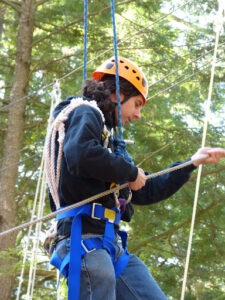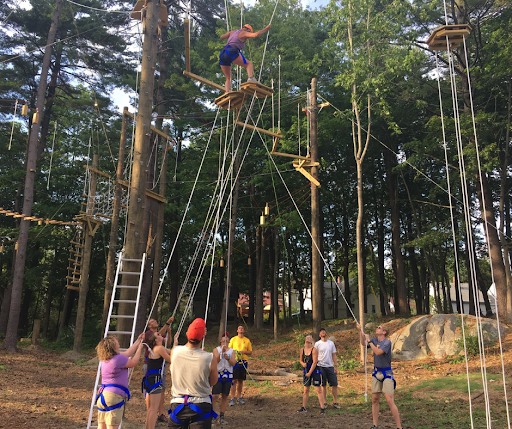The Struggle Is Real:
Perspectives in Adventure Education Programming
By Lisa Hunt
“It’s a challenge course, not a success course,” a practitioner said under their breath, as they watched a belayer give so much tension that it assisted a climber easily across a challenge course ropes element. This moment is relatable to most of us, even if we can’t picture ourselves on a challenge course. These are critical moments for the facilitator, of wanting to provide high structure to our participants so that they experience success, and therefore avoid the pain of struggle, embarrassment, or failure that are a part of being human. Yet sometimes those human instincts put us in the way of someone’s personal growth and insight. It can be a real struggle to find balance in these situations as a facilitator – where do you draw the line?

Approaching the Question of Struggle
There are so many angles from which to address this topic, and they are all important:
- We can consider our own comfort as educators
- We can look at the barriers that are in place for educators who want to allow their students to struggle in the spirit of learning
- We can look at situations where we would want to intentionally NOT design for struggle, which is very valid.
Let’s look at it from the angle of program design, and continue to use the challenge course, as well as group games, as examples.
Feeling Supported to Experience Risk and Vulnerability
One of my favorite group games is called Push Catch. It’s a simple game that involves tossing and catching a ball, and following directions with a sort of Simon Says feel. Push Catch is an elimination game – so if you don’t catch or push the ball when you’re supposed to, you’re out of the game. Most of the time when I introduce this game in a professional development workshop, educators will comment that they have concerns about their participants being eliminated from the game, and they want to create variations that will serve to minimize the sense of performance, risk and vulnerability for participants.
On the other hand, when I play this game with youth groups, they seem to love it and will ask to play it over and over. These are generalities of course, but it makes me wonder: Are we “saving” the opportunity for risk, “failure”, and vulnerability for BIG events (such as a high challenge course experience or a school play) instead of providing those opportunities for practice in lower risk, everyday situations? If I am eliminated from the game of Push Catch, a lot of things could happen. I might feel embarrassed. I might learn something to apply next time. I might hear encouraging words from my peers. I might be teased. In the end, it may seem ideal to avoid experiencing any of those things.
And what if we don’t practice those everyday emotions and behaviors – feeling embarrassed, being supported, and instead we steer our students toward comfort and success? I think it’s safe to assume that the BIG events like climbing on the challenge course for the first time may be even more intimidating. I have observed that when I can give a group – adult or youth – opportunities to struggle and experience activities with unknown outcomes or that don’t always end in success throughout a program, those participants are more likely to fully engage in a peak experience such as a challenge course climb.
The first time I facilitated a workshop around this subject, I invited a group of adults to play a round of Push Catch. Then I asked them to brainstorm all of the emotions or aspects of the game that they could think of, and the list consisted of things like risk, fear, support, “what if I can’t do it,” embarrassment, pride, and much more. Later in the session, I asked the same group to list out all of the emotions or aspects that a climber might feel when they climb for the first time in front of peers. And the Push Catch list and the Climb list were almost identical.

Helpful Prompts to Start Conversations
It’s not enough to simply say “do activities that are riskier early on in a program.” We have to look at how we facilitate and how we as educators help a group process their own emotions and their own behavior. If folks are left feeling embarrassed or targeted, for example, after Push Catch, it only becomes a valuable activity and lesson if it becomes a step in a broader conversation and lesson. “How do we want to treat each other when we are taking a risk?” is a great topic for any group to explore. Prompts like this serve to support a group in learning how their emotions impact their behavior and their own sense of personal risk.
If the concept is appealing, and you’re not sure where to start, consider this approach: have a conversation with your participants about the concept of risk-taking or struggle.

This is one example of a prompt. Follow the conversation with an activity that may highlight some of those aspects. Then talk about it again. This simple progression of framing-activity-debrief is a very worthy investment of time and energy.
This isn’t about removing struggle. It’s about creating conditions that let our participants know that struggle, vulnerability and failure, can be part of a vibrant and productive learning experience. The struggle IS real – and really worthwhile!
What’s Next…
For concrete facilitation tips and strategies for allowing a bit of messiness in your groups, I encourage you to…
- Check out this Facilitating Problem-Solving Episode of Vertical Playpen, a weekly Podcast curated by High 5.
- Please feel free to share your ideas and stories from your experiences in experiential programming where the struggle is real by sending us a message at info@high5adventure.org. We’d love to hear from you!
- Download a copy of Push Catch and enjoy it with your group!
- Sign up for our e-newsletter so you never miss another blog. Find facilitation tips, skill-building workshops, SEL ideas, product specials, and more. You can unsubscribe at any time.
